Jana Kosecka
TRAVEL: Training-Free Retrieval and Alignment for Vision-and-Language Navigation
Feb 11, 2025



Abstract:In this work, we propose a modular approach for the Vision-Language Navigation (VLN) task by decomposing the problem into four sub-modules that use state-of-the-art Large Language Models (LLMs) and Vision-Language Models (VLMs) in a zero-shot setting. Given navigation instruction in natural language, we first prompt LLM to extract the landmarks and the order in which they are visited. Assuming the known model of the environment, we retrieve the top-k locations of the last landmark and generate $k$ path hypotheses from the starting location to the last landmark using the shortest path algorithm on the topological map of the environment. Each path hypothesis is represented by a sequence of panoramas. We then use dynamic programming to compute the alignment score between the sequence of panoramas and the sequence of landmark names, which match scores obtained from VLM. Finally, we compute the nDTW metric between the hypothesis that yields the highest alignment score to evaluate the path fidelity. We demonstrate superior performance compared to other approaches that use joint semantic maps like VLMaps \cite{vlmaps} on the complex R2R-Habitat \cite{r2r} instruction dataset and quantify in detail the effect of visual grounding on navigation performance.
Structured Spatial Reasoning with Open Vocabulary Object Detectors
Oct 09, 2024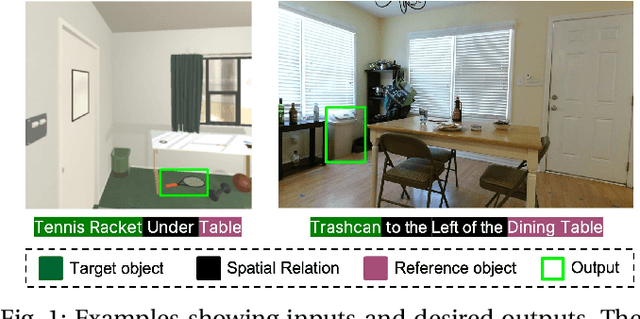
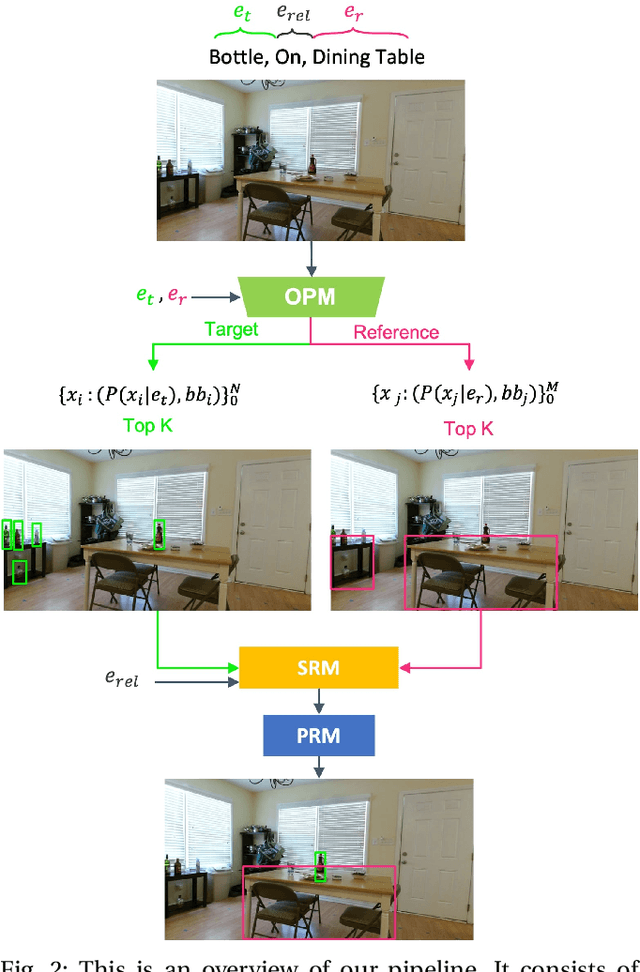
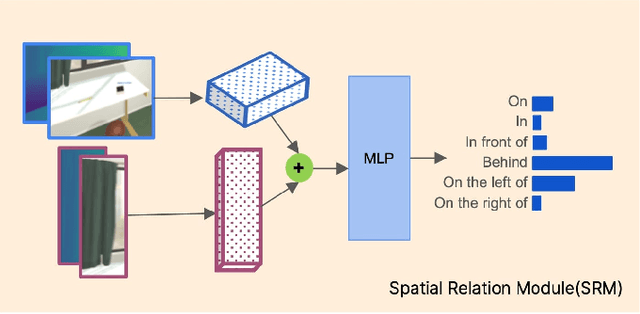
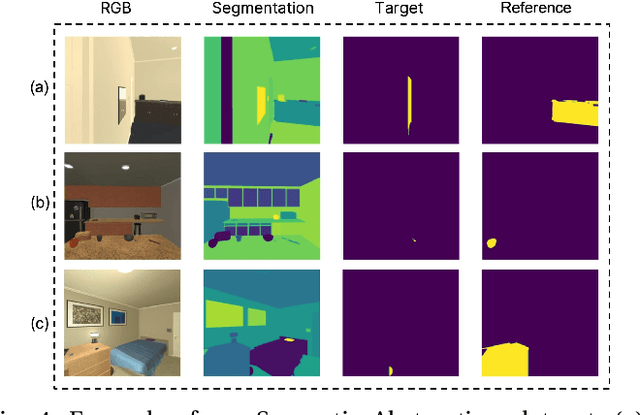
Abstract:Reasoning about spatial relationships between objects is essential for many real-world robotic tasks, such as fetch-and-delivery, object rearrangement, and object search. The ability to detect and disambiguate different objects and identify their location is key to successful completion of these tasks. Several recent works have used powerful Vision and Language Models (VLMs) to unlock this capability in robotic agents. In this paper we introduce a structured probabilistic approach that integrates rich 3D geometric features with state-of-the-art open-vocabulary object detectors to enhance spatial reasoning for robotic perception. The approach is evaluated and compared against zero-shot performance of the state-of-the-art Vision and Language Models (VLMs) on spatial reasoning tasks. To enable this comparison, we annotate spatial clauses in real-world RGB-D Active Vision Dataset [1] and conduct experiments on this and the synthetic Semantic Abstraction [2] dataset. Results demonstrate the effectiveness of the proposed method, showing superior performance of grounding spatial relations over state of the art open-source VLMs by more than 20%.
GSR-BENCH: A Benchmark for Grounded Spatial Reasoning Evaluation via Multimodal LLMs
Jun 19, 2024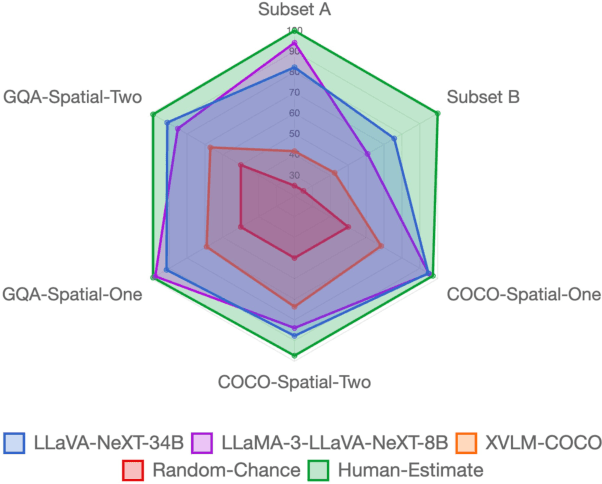

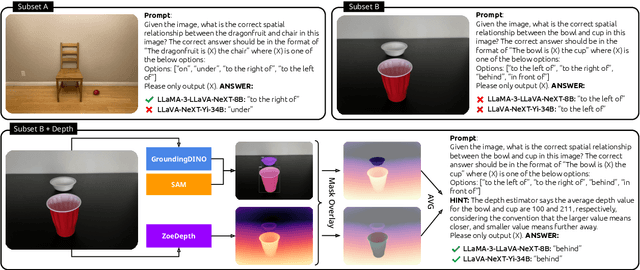

Abstract:The ability to understand and reason about spatial relationships between objects in images is an important component of visual reasoning. This skill rests on the ability to recognize and localize objects of interest and determine their spatial relation. Early vision and language models (VLMs) have been shown to struggle to recognize spatial relations. We extend the previously released What'sUp dataset and propose a novel comprehensive evaluation for spatial relationship understanding that highlights the strengths and weaknesses of 27 different models. In addition to the VLMs evaluated in What'sUp, our extensive evaluation encompasses 3 classes of Multimodal LLMs (MLLMs) that vary in their parameter sizes (ranging from 7B to 110B), training/instruction-tuning methods, and visual resolution to benchmark their performances and scrutinize the scaling laws in this task.
Q-GroundCAM: Quantifying Grounding in Vision Language Models via GradCAM
Apr 29, 2024



Abstract:Vision and Language Models (VLMs) continue to demonstrate remarkable zero-shot (ZS) performance across various tasks. However, many probing studies have revealed that even the best-performing VLMs struggle to capture aspects of compositional scene understanding, lacking the ability to properly ground and localize linguistic phrases in images. Recent VLM advancements include scaling up both model and dataset sizes, additional training objectives and levels of supervision, and variations in the model architectures. To characterize the grounding ability of VLMs, such as phrase grounding, referring expressions comprehension, and relationship understanding, Pointing Game has been used as an evaluation metric for datasets with bounding box annotations. In this paper, we introduce a novel suite of quantitative metrics that utilize GradCAM activations to rigorously evaluate the grounding capabilities of pre-trained VLMs like CLIP, BLIP, and ALBEF. These metrics offer an explainable and quantifiable approach for a more detailed comparison of the zero-shot capabilities of VLMs and enable measuring models' grounding uncertainty. This characterization reveals interesting tradeoffs between the size of the model, the dataset size, and their performance.
Fingerspelling PoseNet: Enhancing Fingerspelling Translation with Pose-Based Transformer Models
Nov 20, 2023Abstract:We address the task of American Sign Language fingerspelling translation using videos in the wild. We exploit advances in more accurate hand pose estimation and propose a novel architecture that leverages the transformer based encoder-decoder model enabling seamless contextual word translation. The translation model is augmented by a novel loss term that accurately predicts the length of the finger-spelled word, benefiting both training and inference. We also propose a novel two-stage inference approach that re-ranks the hypotheses using the language model capabilities of the decoder. Through extensive experiments, we demonstrate that our proposed method outperforms the state-of-the-art models on ChicagoFSWild and ChicagoFSWild+ achieving more than 10% relative improvement in performance. Our findings highlight the effectiveness of our approach and its potential to advance fingerspelling recognition in sign language translation. Code is also available at https://github.com/pooyafayyaz/Fingerspelling-PoseNet.
Labeling Indoor Scenes with Fusion of Out-of-the-Box Perception Models
Nov 17, 2023Abstract:The image annotation stage is a critical and often the most time-consuming part required for training and evaluating object detection and semantic segmentation models. Deployment of the existing models in novel environments often requires detecting novel semantic classes not present in the training data. Furthermore, indoor scenes contain significant viewpoint variations, which need to be handled properly by trained perception models. We propose to leverage the recent advancements in state-of-the-art models for bottom-up segmentation (SAM), object detection (Detic), and semantic segmentation (MaskFormer), all trained on large-scale datasets. We aim to develop a cost-effective labeling approach to obtain pseudo-labels for semantic segmentation and object instance detection in indoor environments, with the ultimate goal of facilitating the training of lightweight models for various downstream tasks. We also propose a multi-view labeling fusion stage, which considers the setting where multiple views of the scenes are available and can be used to identify and rectify single-view inconsistencies. We demonstrate the effectiveness of the proposed approach on the Active Vision dataset and the ADE20K dataset. We evaluate the quality of our labeling process by comparing it with human annotations. Also, we demonstrate the effectiveness of the obtained labels in downstream tasks such as object goal navigation and part discovery. In the context of object goal navigation, we depict enhanced performance using this fusion approach compared to a zero-shot baseline that utilizes large monolithic vision-language pre-trained models.
Towards Grounded Visual Spatial Reasoning in Multi-Modal Vision Language Models
Aug 18, 2023



Abstract:With the advances in large scale vision-and-language models (VLMs) it is of interest to assess their performance on various visual reasoning tasks such as counting, referring expressions and general visual question answering. The focus of this work is to study the ability of these models to understanding spatial relations. Previously, this has been tackled using image-text matching (Liu, Emerson, and Collier 2022) or visual question answering task, both showing poor performance and a large gap compared to human performance. To better understand the gap, we present fine-grained compositional grounding of spatial relationships and propose a bottom up approach for ranking spatial clauses and evaluating the performance of spatial relationship reasoning task. We propose to combine the evidence from grounding noun phrases corresponding to objects and their locations to compute the final rank of the spatial clause. We demonstrate the approach on representative vision-language models (Tan and Bansal 2019; Gupta et al. 2022; Kamath et al. 2021) and compare and highlight their abilities to reason about spatial relationships.
Graph-CoVis: GNN-based Multi-view Panorama Global Pose Estimation
Apr 26, 2023



Abstract:In this paper, we address the problem of wide-baseline camera pose estimation from a group of 360$^\circ$ panoramas under upright-camera assumption. Recent work has demonstrated the merit of deep-learning for end-to-end direct relative pose regression in 360$^\circ$ panorama pairs [11]. To exploit the benefits of multi-view logic in a learning-based framework, we introduce Graph-CoVis, which non-trivially extends CoVisPose [11] from relative two-view to global multi-view spherical camera pose estimation. Graph-CoVis is a novel Graph Neural Network based architecture that jointly learns the co-visible structure and global motion in an end-to-end and fully-supervised approach. Using the ZInD [4] dataset, which features real homes presenting wide-baselines, occlusion, and limited visual overlap, we show that our model performs competitively to state-of-the-art approaches.
U2RLE: Uncertainty-Guided 2-Stage Room Layout Estimation
Apr 17, 2023



Abstract:While the existing deep learning-based room layout estimation techniques demonstrate good overall accuracy, they are less effective for distant floor-wall boundary. To tackle this problem, we propose a novel uncertainty-guided approach for layout boundary estimation introducing new two-stage CNN architecture termed U2RLE. The initial stage predicts both floor-wall boundary and its uncertainty and is followed by the refinement of boundaries with high positional uncertainty using a different, distance-aware loss. Finally, outputs from the two stages are merged to produce the room layout. Experiments using ZInD and Structure3D datasets show that U2RLE improves over current state-of-the-art, being able to handle both near and far walls better. In particular, U2RLE outperforms current state-of-the-art techniques for the most distant walls.
Comparison of Model-Free and Model-Based Learning-Informed Planning for PointGoal Navigation
Dec 17, 2022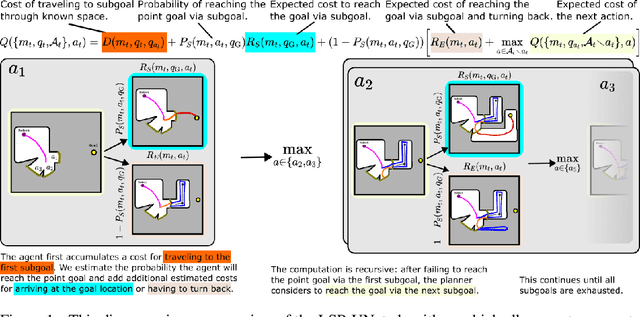
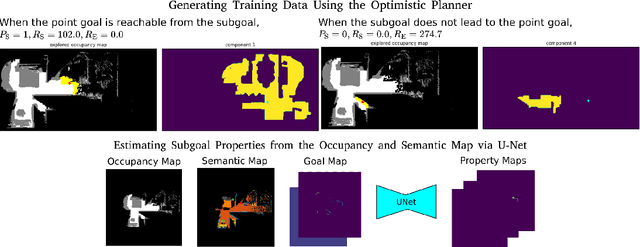
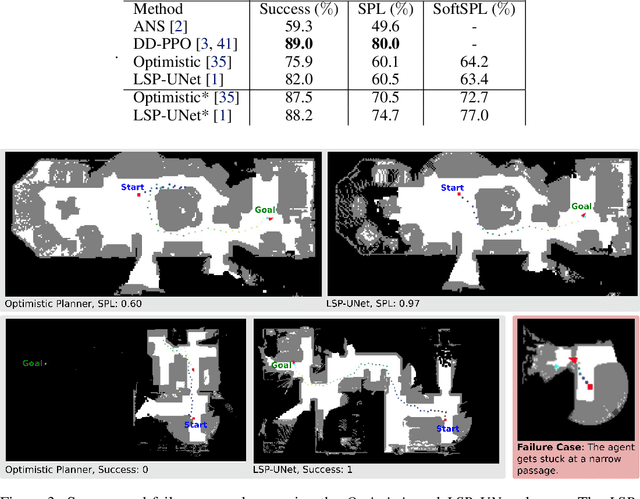
Abstract:In recent years several learning approaches to point goal navigation in previously unseen environments have been proposed. They vary in the representations of the environments, problem decomposition, and experimental evaluation. In this work, we compare the state-of-the-art Deep Reinforcement Learning based approaches with Partially Observable Markov Decision Process (POMDP) formulation of the point goal navigation problem. We adapt the (POMDP) sub-goal framework proposed by [1] and modify the component that estimates frontier properties by using partial semantic maps of indoor scenes built from images' semantic segmentation. In addition to the well-known completeness of the model-based approach, we demonstrate that it is robust and efficient in that it leverages informative, learned properties of the frontiers compared to an optimistic frontier-based planner. We also demonstrate its data efficiency compared to the end-to-end deep reinforcement learning approaches. We compare our results against an optimistic planner, ANS and DD-PPO on Matterport3D dataset using the Habitat Simulator. We show comparable, though slightly worse performance than the SOTA DD-PPO approach, yet with far fewer data.
 Add to Chrome
Add to Chrome Add to Firefox
Add to Firefox Add to Edge
Add to Edge